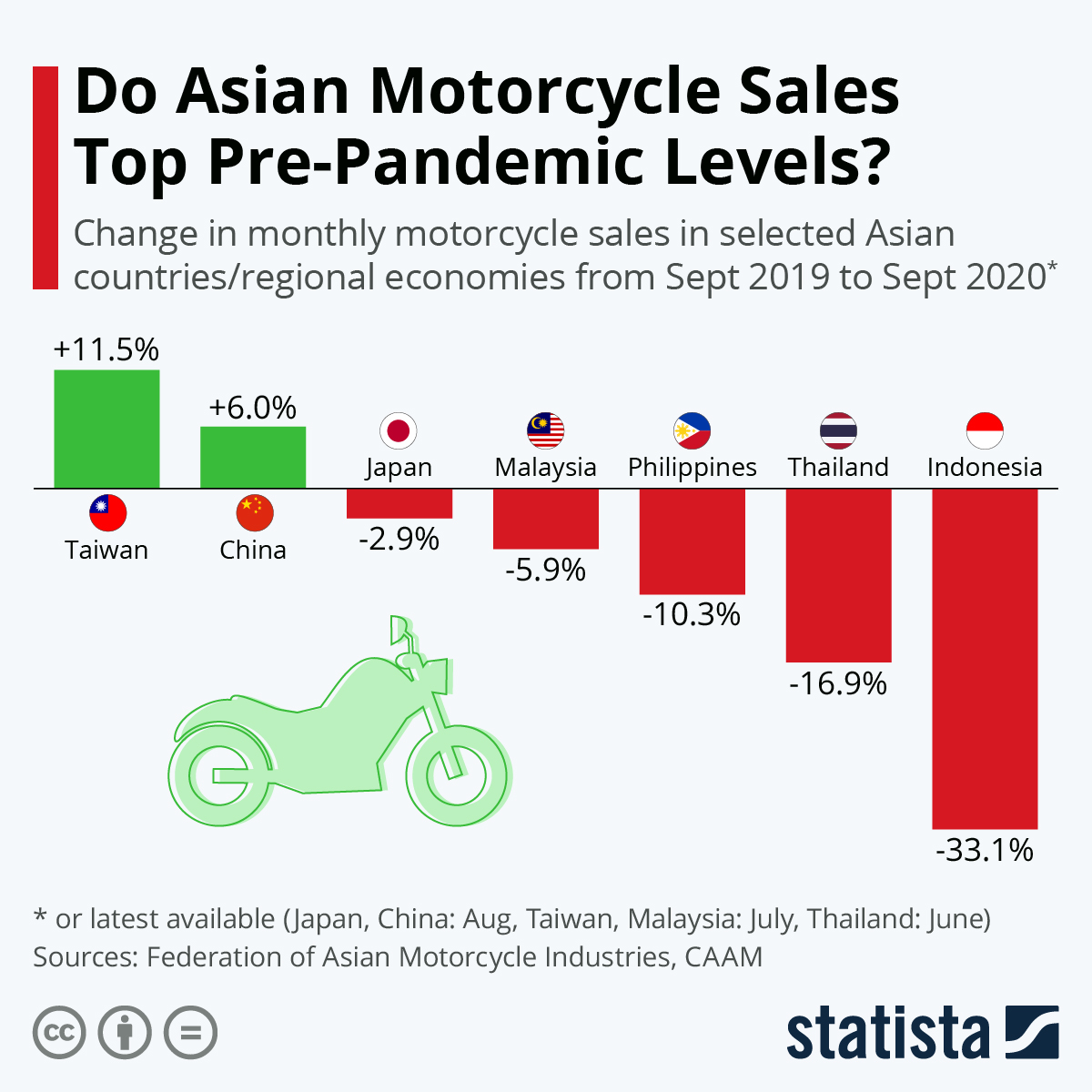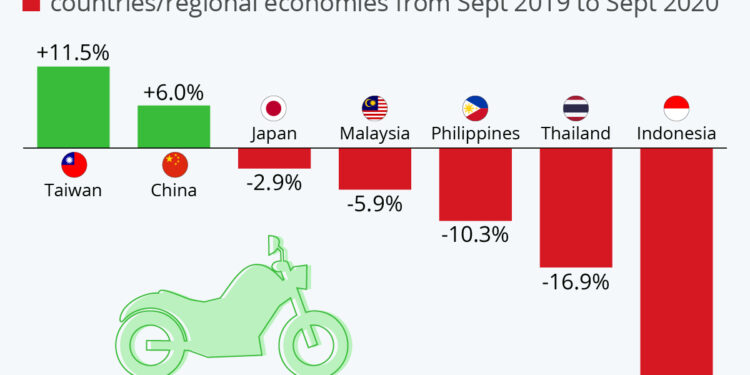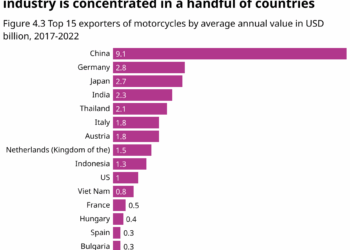Dive into the dynamic world of the Asia motorcycle market analysis, where trends, key players, and cultural influences converge to shape the industry. Get ready for a journey through the past, present, and future of motorcycles in Asia.
Explore the economic, cultural, and regulatory factors that drive this market forward, and uncover the exciting technological trends that are revolutionizing the way we ride.
Overview of the Asia Motorcycle Market

The Asia motorcycle market has a rich history dating back to the early 20th century when motorcycles became popular modes of transportation. Today, the market has grown significantly and plays a crucial role in the automotive industry.The current size of the Asia motorcycle market is substantial, with a steady growth trend over the years.
As economies in the region continue to develop, the demand for motorcycles as affordable and convenient transportation options has increased.
Key Players in the Asia Motorcycle Market
- Honda: As one of the largest motorcycle manufacturers in the world, Honda has a strong presence in the Asia market with a wide range of models catering to different consumer needs.
- Yamaha: Another major player in the Asia motorcycle market, Yamaha is known for its innovative designs and reliable performance, attracting a loyal customer base.
- Suzuki: Suzuki has a solid reputation for producing high-quality motorcycles that are popular among riders in Asia, contributing to its market share in the region.
Major Regions in the Asia Motorcycle Market
- India: With a massive population and increasing urbanization, India is a key market for motorcycles in Asia. Brands like Hero MotoCorp and Bajaj Auto dominate the Indian motorcycle industry.
- China: The largest motorcycle market in the world, China is home to local brands like Lifan and Loncin, along with international players competing for market share.
- Southeast Asia: Countries like Indonesia, Thailand, and Vietnam are significant markets for motorcycles in Asia, with a growing demand for scooters and commuter bikes.
Factors Influencing the Asia Motorcycle Market

Economic factors, cultural influences, and regulatory factors play a significant role in shaping the dynamics of the motorcycle market in Asia.
Economic Factors
Income levels and GDP growth are crucial economic factors that impact the demand for motorcycles in Asia. As disposable incomes rise and economies grow, more people have the purchasing power to buy motorcycles for personal transportation or business purposes. Countries experiencing rapid economic development often see a surge in motorcycle sales as a result.
Cultural Influences
Motorcycle usage and preferences in different Asian countries are heavily influenced by cultural factors. For example, in countries like India and Vietnam, motorcycles are a popular mode of transportation due to their affordability and convenience in navigating congested urban areas.
In contrast, in countries like Japan and South Korea, motorcycles are often seen as recreational vehicles rather than primary modes of transport.
Regulatory Factors
Regulatory factors such as emission standards and safety regulations also play a significant role in the Asia motorcycle market. With increasing concerns about environmental pollution, many Asian countries are implementing stricter emission standards for motorcycles to reduce harmful emissions. Additionally, safety regulations regarding helmet use, speed limits, and vehicle inspections impact the market by influencing consumer choices and industry practices.
Market Segmentation in Asia
When it comes to the motorcycle market in Asia, segmentation plays a vital role in understanding the diverse preferences of consumers. By breaking down the market based on types of motorcycles, we can gain insights into the popularity and growth potential of each segment, as well as the target demographics for these categories.
Types of Motorcycles
- Scooters: Scooters are a popular choice in densely populated urban areas, offering ease of maneuverability and fuel efficiency. They are often preferred by younger riders or commuters looking for a convenient mode of transportation.
- Sports Bikes: Sports bikes appeal to enthusiasts and thrill-seekers who seek high performance and speed. This segment often targets a younger demographic interested in racing or adrenaline-pumping rides.
- Cruisers: Cruisers are known for their laid-back riding style and comfortable seating, making them a favorite among riders looking for a relaxed and leisurely experience on the road. This category typically caters to older riders or those seeking a more classic aesthetic.
Popularity and Growth Potential
While scooters dominate the market in terms of sheer numbers due to their practicality and affordability, sports bikes are gaining popularity among the younger generation, especially in countries with a growing interest in motorsports. Cruisers, on the other hand, have a niche following but are seeing steady growth as more riders appreciate their unique design and features.
Target Demographics
| Motorcycle Type | Target Demographics |
|---|---|
| Scooters | Youthful urban commuters, first-time riders, and budget-conscious individuals. |
| Sports Bikes | Enthusiasts, thrill-seekers, and young riders interested in high-speed performance. |
| Cruisers | Older riders, touring enthusiasts, and riders looking for a more laid-back riding experience. |
Technological Trends in the Asia Motorcycle Market

Electric motorcycles, connectivity features, and autonomous technology are shaping the future of the Asia motorcycle market.
Advancements in Electric Motorcycles
Electric motorcycles are gaining traction in Asian countries due to their eco-friendly nature and cost-effectiveness. Countries like China and India are leading the way in electric motorcycle adoption, with government incentives driving growth in this sector.
Impact of Connectivity Features and Smart Technology
Connectivity features such as GPS navigation, Bluetooth connectivity, and smartphone integration are becoming increasingly common in motorcycles across Asia. These features enhance the riding experience, improve safety, and provide valuable data for manufacturers to analyze and improve their products.
Shift towards Autonomous Motorcycles
The concept of autonomous motorcycles, equipped with sensors and AI technology to assist riders or even operate independently, is still in the early stages in Asia. Challenges such as regulatory hurdles, safety concerns, and consumer acceptance need to be addressed before autonomous motorcycles become mainstream in the region.
Ultimate Conclusion
As we conclude our exploration of the Asia motorcycle market analysis, it's clear that this industry is a vibrant tapestry of innovation and tradition. From the bustling streets of major regions to the cutting-edge advancements in technology, the future of motorcycles in Asia is bound to be thrilling and full of surprises.
Top FAQs
What are the key players in the Asia motorcycle market?
The key players in the Asia motorcycle market include Honda, Yamaha, Suzuki, and Kawasaki.
How do cultural influences impact motorcycle preferences in Asia?
Cultural influences play a significant role in shaping motorcycle preferences in Asia, with factors like style, brand perception, and societal norms influencing consumer choices.
What are the growth trends in the Asia motorcycle market?
The Asia motorcycle market is experiencing steady growth, fueled by increasing demand, technological advancements, and changing consumer preferences.











